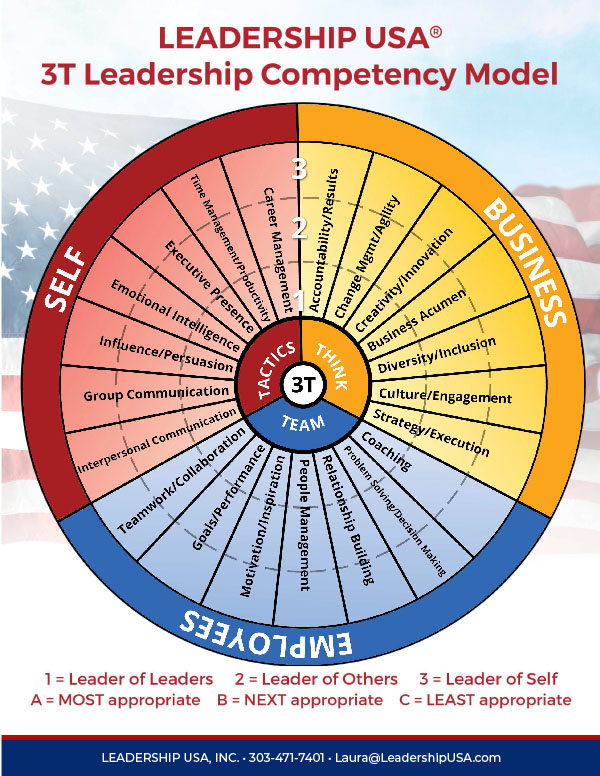To be competent as a leader, you must possess certain skills, knowledge, and capacities. At LEADERSHIP USA, we define 21 leadership competencies, grouped into three categories we call the “3T Leadership Competencies” in a wheel:
THINK (Managing the Business)
Acting as the organizational strategist who focuses on business goals. The executive monitors the big picture and makes sure the team efforts reinforce the company’s goals.
TEAM (Managing Others)
Serving as the conscientious leader who focuses on employee productivity. The executive builds and maintains an effective, productive team as the first step toward high performance.
TACTICS (Managing Self)
Being the productive performer who focuses on task completion. The executive completes his or her individual duties and carries out any day-to-day, operational activities.
Our 21 competencies help you develop your leadership abilities in these areas:
THINK
- Accountability/Results—Answer to organizational stakeholders for actions and results
- Change Mgmt/Agility—Guide the organization, teams, and individuals through transitions
- Creativity/Innovation—Introduce creative and innovate solutions
- Business Acumen—See the big picture and understand financial metrics
- Diversity/Inclusion—Recognize the need for and champion diversity and inclusivity
- Culture/Engagement—Shape a culture that engages employees and reflects core values
- Strategy/Execution—Create and carry out a strategy for future success
TEAM
- Coaching—Coach others to promote their growth and development
- Problem Solving/Decision Making—Work with others on a common goal or specific problem
- Relationship Building—Connect and bond with others to create mutually supportive partnerships
- People Management—Possess effective managerial skills, such as delegating and mentoring
- Motivation/Inspiration—Motivate and inspire employees to give their best
- Goals/Performance—Plan, monitor, and review an employee’s objectives and contributions
- Teamwork/Collaboration—Promote cooperation to complete tasks in the most effective and efficient way
TACTICS
- Interpersonal Communication—Listen actively, give feedback, resolve conflict one-on-one.
- Group Communication—Facilitate meetings, give presentations, and make decisions with groups
- Influence/Persuasion—Impact the attitude and behavior of others to achieve a specific result
- Emotional Intelligence—Display an emotional awareness of yourself and others
- Executive Presence—Convey confidence and authority through your demeanor and behavior
- Time Management/Productivity—Maintain organized workflow and effective time management
- Career Management— Plan and actively manage one’s own professional career
To determine which LEADERSHIP USA courses to attend, visit the course description for the learning event you’re interested in attending. The instructor has identified which competencies are covered in the course, as well as the target leadership level (Level 1-3).
Most Appropriate; Next Appropriate:
Level 1 = Leader of Leaders
Level 2 = Leader of Others
Level 3 = Leader of Self
